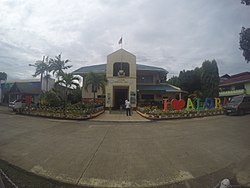Aloran | |
|---|---|
| Municipality of Aloran | |
 Municipal hall | |
| Nickname: Heart of MisOcc | |
 Map of Misamis Occidental with Aloran highlighted | |
 Interactive map of Aloran | |
Location within the Philippines | |
| Coordinates: 8°24′53″N123°49′22″E / 8.414622°N 123.822781°E | |
| Country | Philippines |
| Region | Northern Mindanao |
| Province | Misamis Occidental |
| District | 1st district |
| Founded | January 1, 1917 |
| Barangays | 38 (see Barangays) |
| Government | |
| • Type | Sangguniang Bayan |
| • Mayor | Guardson D. Mutia (ASPIN) |
| • Vice Mayor | Junipher A. Roa (ASPIN) |
| • Representative | Jason P. Almonte (NP) |
| • Municipal Council | Members |
| • Electorate | 20,411 voters (2025) |
| Area | |
• Total | 118.06 km2 (45.58 sq mi) |
| Elevation | 50 m (160 ft) |
| Highest elevation | 303 m (994 ft) |
| Lowest elevation | 0 m (0 ft) |
| Population (2024 census) [3] | |
• Total | 28,095 |
| • Density | 237.97/km2 (616.35/sq mi) |
| • Households | 6,958 |
| Economy | |
| • Income class | 3rd municipal income class |
| • Poverty incidence | 28.08 |
| • Revenue | ₱ 175.8 million (2022) |
| • Assets | ₱ 372.3 million (2022) |
| • Expenditure | ₱ 151.1 million (2022) |
| • Liabilities | ₱ 116.2 million (2022) |
| Service provider | |
| • Electricity | Misamis Occidental 1 Electric Cooperative (MOELCI 1) |
| Time zone | UTC+8 (PST) |
| ZIP code | 7206 |
| PSGC | |
| IDD : area code | +63 (0)88 |
| Native languages | Subanon Cebuano Tagalog |
| Website | www |
Aloran, officially the Municipality of Aloran (Cebuano : Lungsod sa Aloran; Tagalog : Bayan ng Aloran), is a municipality in the province of Misamis Occidental, Philippines. According to the 2024 census, it has a population of 28,095 people. [5]






